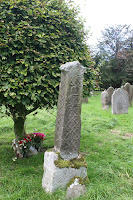 |
| St Oswald's Church, Hauxwell |
 |
| Norman Arch, Hauwell Church |
Today, I visited St Oswald's, Hauxwell, surely one of our more remote churches. There has been a place of worship on this site since at least the seventh century and possibly longer. St Paulinus is associated with the Christianization of the area and the site has Saxon remains. As you walk up the path to this gem of a building, an Anglo-Danish Preaching Cross in the churchyard reminds you of the fusion of Anglian and Dane, as invader and invaded came to acknowledge that they had a common Christian faith. There is a wonderful Norman arch, a font which has mediaeval and Elizabethan features and an unusually long chancel with several interesting memorials including one to Sir John Dalton who was killed accompanying Queen Henrietta Maria (Charles I's consort) from Bridlington to Oxford shortly before the Commonwealth and her husband's arrest, trial and execution. Reading all the memorials gives you a wonderful insight into the variety of life, rich and poor, short and long-lived, in a Yorkshire country village.
I was also intrigued by the story of a local girl, Dorothy Wyndlow Pattison, the daughter of the Rector of the parish. She was born in 1832, the tenth daughter of the Revd James Pattison and his wife Jane Winn, whose father had been Mayor of Richmond. From all accounts she had a fairly difficult childhood as her father suffered from mental illness and severely constrained the lives of his unmarried daughters. (Apparently he used to rebuke his unfortunate family from the pulpit!) In 1861, following the death of her mother, she broke away from home and, to begin with, took a teaching post. She then fell ill and went to Marske near Redcar to recuperate. Here she worked with the Christ Church Sisterhood, an Anglican Order which was devoted to prayer and caring for the poor and the sick. The Order was inspired by the Oxford Movement and so this further alienated her from her father who was a strict Evangelical. Dora (as she was now known) was trained in nursing at the Cottage Hospital in Cleveland and the Order's convalescent home. This was the era of Florence Nightingale and the beginning of systematic training for nurses who were badly needed to tend the burgeoning populations of the industrial cities. Owing to the fact that another of the Sisters fell ill, Dora was sent to Walsall in Staffordshire to help set up a hospital.
By all accounts, this became a flourishing enterprise with facilities for surgery, men's and women's wards and a large out-patients clinic which Dora mostly ran herself, seeing almost 15,000 patients in one year. Dr Judith Gowland, in her 'Brief Life ' of Sister Dora, quotes from a pupil nurse who describes a typical day. At 6.30am Sister Dora came onto the wards, made beds, gave the patients their breakfast, led prayers and then dressed wounds. From 11am she supervised ward rounds and lunches, sometimes missing lunch herself if there were emergencies. From 2pm she ran the out-patients' clinics often seeing as many as 60-100 people. She dressed wounds (asepsis was in its infancy), set bones and extracted teeth - all pretty physically demanding work! From 5pm she would come onto the wards and 'there would be talk and laughter, hymn singing and stories' followed by supper and prayers. She carried this routine on for 13 years and, despite the odd physical collapse, made a huge impression on the local community by her dedicated care for those who had suffered as a result of colliery and ironworks disasters and during a smallpox epidemic. When she died in 1878, 18 railway men carried her coffin into a packed church. The townspeople erected a statue for her and a stained glass window in her honour was placed in Walsall parish church. This daughter of Yorkshire had made a great contribution to healthcare in Staffordshire, bringing techniques forged on the battle fields to civilian hospitals at the height of the industrial revolution. She nursed in an age when nurses risked their own lives to care for patients with infections and contagious diseases.
On the walls of the peaceful church at Hauxwell and in the churchyard you can read the stories of those who died young and one wonders if these stories had their place in shaping the vocation of the young Dora as she sat, trying to ignore her father's frequent tirades against his own family. Today the church is well cared-for and welcoming with a beatuiful millenium banner made by villagers, a small exhibition and information for visitors. Next week is the harvest festival when the church will be full.




No comments:
Post a Comment